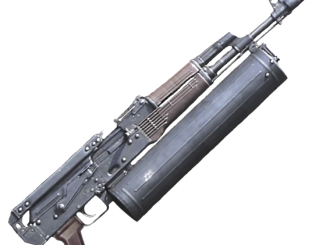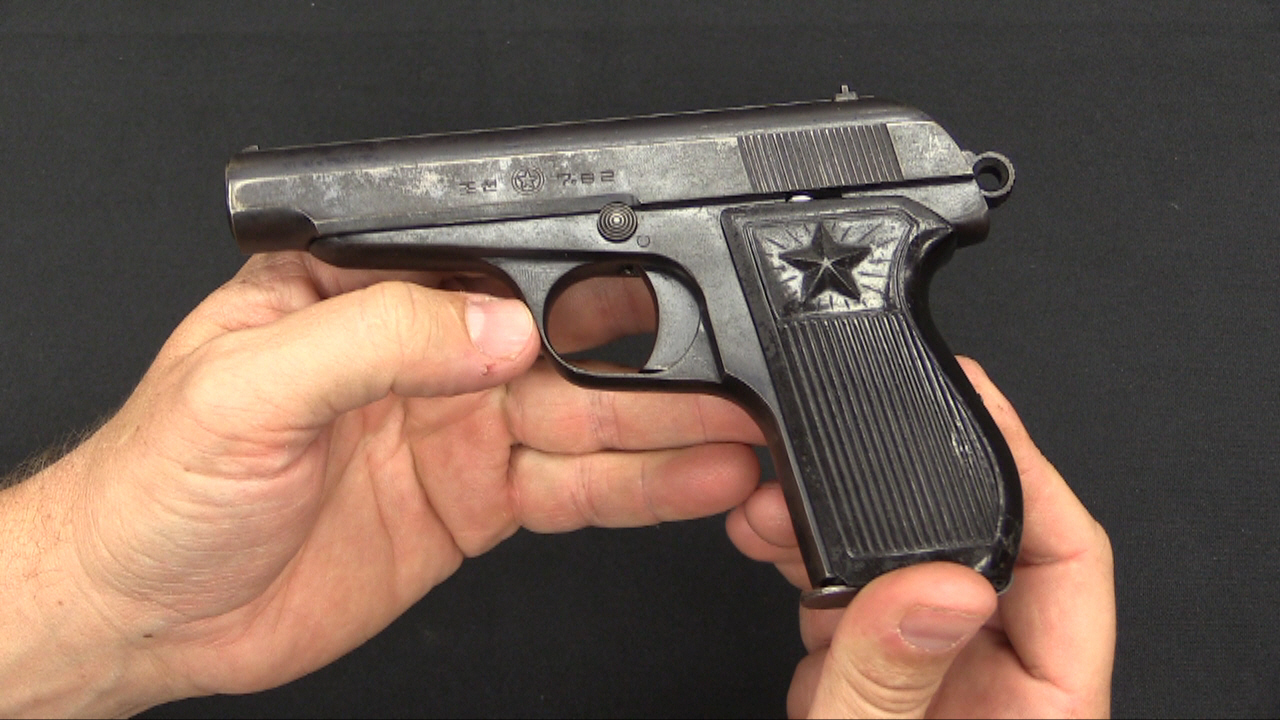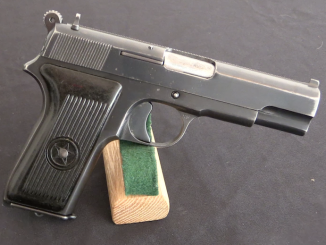Note: I mistakenly referred to North Korea in the video, when this was actually made in South Korea. Sorry!
During (and probably for a short time after) the Korean War, a Korean facility called the Pusan Iron Works did fabrication and repair of 1911-style pistols. This particular example is serial number 247, a gun almost completely fabricated by Pusan. Interestingly, these pistols often include a small number of US-made parts (barrels seem to be the most common). It appears that the factory was able to secure a small number of parts from captured damaged US 1911 pistols, and made use of them when possible. This pistol has a firing pin and recoil spring guide that are American-made. In addition, I am aware of at least one pistol with an American complete frame but Pusan slide – likely a gun that was captured in unserviceable condition and repaired with Korean parts.
Pusan Iron Works is an example of the blurry zone between truly crude handmade guns and proper factories. Unlike some Chinese or Vietnamese gun copies, the Pusan pistols are fully functional mechanical copies of the 1911 – no dummy elements like non-functional safeties. However,r the production quality of the Pusan parts is low; made to the right basic shapes, but apparently without the benefit of jigs and fixtures to make parts identical and interchangeable. The Pusan guns also exhibit uniform markings, and several hundred were definitely made – unlike the one-off production of individual craft shops. They are a really interesting example of domestic Korean wartime production arms.




Great video, as usual Ian! This brought up something that I really need your insight on; I’m working and living in Japan, and I just came back from a vacation in Hiroshima. During my stay there, I found, in an unlikely place (a street-side camera lens shop), a leather holster with the Japanese Navy emblem embossed on the cover flap. The document with it claimed to come from Naval surplus in 1991, but when I did my own informal research, I found that the holster is an exact copy of the M1916 holster for the 1911, sans the “U.S.” stamping on the flap (and without two cuts on the backside, which would have allowed a belt to go through). I was dubious about the validity of the holster as genuine Japanese Navy equipment (Japan has never adopted a pistol even close in proportions to the 1911), but I bought the holster and accompanying document anyway out of sheer curiosity. Is there any reason why a 1911-style holster would be issued by the Japanese Navy? And if not, why would someone go through the work of making a new reproduction M1916 holster and doctor it to look like a Japanese Naval holster? Sorry to throw this question at you.
This is just a guess, but when the Japanese Maritime Self-Defense Force (JMSDF) was formed in the 1950s, a lot of its personal equipment (uniforms, leather goods, etc.) was wartime IJN issue. And newly-made items were often made on exiting machinery, including the embossers that put the “navy” property marks, etc., on the finished item.
And as with the rest of the Self-Defense Forces, JMSDF small arms were practically all American types. Notably the M1911A1 .45 automatic pistol. Holsters were of course necessary, and they would have been made on the same machinery, except with new patterns to cut the leather to the correct shape, etc.
As such, what you may have is a circa 1956 or so JMSDF-issue 1911 holster, that was simply embossed with the “old” IJN property emblem on the flap because they were still using it at that time.
As I said, that’s just a guess, take it for what it’s worth.
cheers
eon
“exiting”= EXISTING
Blasted sticky “S”.
cheers
eon
Thanks, Eon! That actually makes perfect sense, and makes me feel more secure with my purchase.
Cool another Forgotten weapons fan in Japan.
Yep! I moved to Shizuoka over a year ago, but I’ve been a fan of Forgotten Weapons for about five years now. Are you in Japan as well?
I have lived in Nagoya for ten years now. It’s difficult to find another gaijin that’s into history and firearms here. Type in Nanbu type 11 tripod and you can see my wife’s grandfathers pics of him and the rare Type 11 tripod on this site.
That is beyond cool! You actually have a connection to that history in a way many do not! And I understand on the lack of foreigner friends who appreciate weapons AND history; it’s usually one of the two, if they like either at all. Nagoya is a pretty regular stop on my travels, yet I have never really explored the city. Maybe I’ll run into you when I visit Nagoya if you have time.
I’d be happy to meet up with you, when will your next time in Nagoya be?
Not sure at the moment; is there a way I can contact you when I know for sure I have time to go there?
Ian
You can contact me at ( mikawab@yahoo.com) Talk to you later.
Blake
Very cool relic.
At first it looked gibberish, then my father point out it is written in old school Korean. Pusan is pronounce Busan in Korean.
It said, left to right: Bu Jin Jae. Bu is acronym of Busan or Pusan, jin means town or city, jae means product, so it roughly translate as Busan Jin Product or Made by Busan Jin.
Also I am confused when you refer as if this gun made by North Korean since Busan was never occupied by North Korean during the Korean War. Look at Pusan Perimeter. Even Rock Island article point it out as South Korean: http://www.rockislandauction.com/detail/68/3528
I am assuming these are commercial pistols made for the Korean civilian possibly black market? I am guessing private ownership of large bore pistols would not be very legal in those days.
There is no peace treaty between the North and South Korea and both still consider themselved as the legitimate government, much in the same way as Republic of China (Taiwan) still considers themselves as the legitimate government of China and Beijing considers Taiwan to be a rebellious province.
Funny you should mention Taiwan. It is rumored that many Chinese businessmen from the mainland use Nationalist held territories (like Kinmen) to conduct deals away from Communist eyes and hide their cash. Since Hong Kong ceased to be British territory in 1997, it is no longer immune to the whims of the Chinese Communist Party and thus no longer safe from Beijing’s influence…
Did I mess up?
It is also possible that Bu Jin Jae is acronym for Busan Jinhaeku Manufacturing(부산 진해구 제작소).
Jinhae is a district(ku roughly means district) on the west part of Busan/Pusan with naval bases, and a factory manufacturing a product is sometimes referred as Je jak so(제작소). Busan was called Busan since 1500s, so I don’t think “jin” would mean city, but I could be wrong.
Another possibility is that the name is that of a company that manufactured it and doesn’t necessarily reflect geographic ties, although I think the chance is really slim.
And thus the problem with early production guns is discovered: no interchangeable parts. It appears that the lack of proper tooling didn’t prevent the South Korean industry from learning to do better later. Ironically, North Korea had more stuff and tooling left over from Imperial Japan but it appears that somebody is content with using Soviet left-overs and improvised “new weapons” in the hopes of scaring America into submission and slavery. Last time I checked in the news about the “Hermit Kingdom,” it was running out of planes due to a huge lack of spare engine parts!!!
Did I mess up?
Is this a known firearms manufacturer? I’m wondering how much the markings can be trusted to be accurate. Also, why would the South need to make copies of U.S. firearms?
My bet is that because the South’s infrastructure got thrashed pretty hard during the war, while they needed pistols (and pretty much everything else) they couldn’t produce enough from scratch and the American military aid wasn’t filling the gap. “Parting out” damaged/destroyed pistols and using those parts plus locally produced parts to jigsaw together whole weapons probably made a deal of economic sense and I’d be surprised if they weren’t doing the same for long arms and other weapons as well.
The markings on the slide and frame both spell 부진제 (Bu Jin Je). It’s just an acronym of Busan Jin Iron Works. 부(산) Bu(san) 진 Jin 제(철소) Je(cheolso). Also, Busanjin is a district in the city of Busan, kinda like New York City, New York – so I’m thinking it’s more like Busanjin Iron Works, rather than the Jin being a separate word. Just speculation on my part, I haven’t done any research into that.
Ian, appreciate everything you have published. The sheer volume of scholarship is impressive.
Can you change the flag on the Busan Iron works pistol?
Folks from Pusan might be offended with a local product being associated with the north.
As to the pistol’s origin, an educated guess might be mid 50s manufacture for sale to GIs as souvenirs.
The Pusan Police might be able to fill in some gaps, because the production of these guns would have been stopped as soon as it was discovered. Under martial law independent production of guns wouldn’t be tolerated.